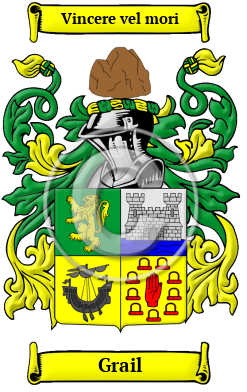| ![Show Contents]() Grail History, Family Crest & Coats of Arms Grail History, Family Crest & Coats of Arms
- Origins Available:
Scotland
Ireland
Etymology of GrailWhat does the name Grail mean? The west coast of Scotland and the rocky Hebrides islands are the ancient home of the Grail family. The root of their name is the personal name Neil. The Gaelic form Mac Neill translates as son of Neil. Early Origins of the Grail familyThe surname Grail was first found in on the islands of Barra, Gigha, Colonsay, and Oronsay. According to traditional records in 1049, Niall, a direct descendent of King Niall of the Nine Hostages, landed in Barra and founded the Clan MacNeill of Barra. However, another kinsman, some believe to be the younger brother of Niall named Anrothan, married a Princess of the Dalriadans, an ancient race from which sprang most of the early Scottish Kings. Legend has it that Anrothan started the MacNeill house of Colonsay through his son Torquil of Taynish. This latter branch acquired the lands of Gigha, Colonsay and Oronsay, beyond the Firth of Lorne. For the next two centuries it appears as though these two great houses were developing independently of one another. Early History of the Grail familyThis web page shows only a small excerpt of our Grail research. Another 361 words (26 lines of text) covering the years 1370, 1380, 1526, 1562, 1590, 1612, 1613, 1631, 1640, 1686, 1730 and 1890 are included under the topic Early Grail History in all our PDF Extended History products and printed products wherever possible. Grail Spelling VariationsSpelling and translation were not standardized practices until the last few centuries. Spelling variations are extremely common among early Scottish names. Grail has been spelled MacNeil, MacNeill, MacNeal, MacNeilage, MacNeale, MacNeall, MacNeille, MacNeel, MacNiel, MacGreal, Mcneil, Mcneill, McNeal, Mcneal, Mcneall and many more. Early Notables of the Grail familyNigel M'Nele, Laird of Blarekanne c. 1370-1380; Alexander Makneyll, a notary public in Edinburgh in 1526; Richard Neile (1562-1640) was an English churchman, Archbishop of York (1631-1640), he was involved in the...
Another 32 words (2 lines of text) are included under the topic Early Grail Notables in all our PDF Extended History products and printed products wherever possible. Migration of the Grail family to IrelandSome of the Grail family moved to Ireland, but this topic is not covered in this excerpt.
Another 85 words (6 lines of text) about their life in Ireland is included in all our PDF Extended History products and printed products wherever possible.
| Grail migration to the United States | + |
Numerous Scottish settlers settled along the east coast of the colonies that would become the United States and Canada. Others traveled to the open country of the west. At the time of the American War of Independence, some remained in the United States, while those who remained loyal to the crown went north to Canada as United Empire Loyalists. The highland games and Clan societies that sprang up across North America in the 20th century have helped many Scots to recover parts of their lost traditions. Research into passenger and immigration lists has revealed some of the very first Grails to arrive in North America:
Grail Settlers in United States in the 18th Century- Isaac Grail, who landed in Pennsylvania in 1740 1
- Johan Adam Grail, who landed in Pennsylvania in 1749 1
- Nicolaus Grail, who arrived in Pennsylvania in 1775 1
- Peter Grail, who landed in Philadelphia, Pennsylvania in 1791 1
Grail Settlers in United States in the 19th Century- Frederick Grail, who arrived in Allegany (Allegheny) County, Pennsylvania in 1875 1
The motto was originally a war cry or slogan. Mottoes first began to be shown with arms in the 14th and 15th centuries, but were not in general use until the 17th century. Thus the oldest coats of arms generally do not include a motto. Mottoes seldom form part of the grant of arms: Under most heraldic authorities, a motto is an optional component of the coat of arms, and can be added to or changed at will; many families have chosen not to display a motto.
Motto: Vincere vel mori
Motto Translation: To conquer or die.
- Filby, P. William, Meyer, Mary K., Passenger and immigration lists index : a guide to published arrival records of about 500,000 passengers who came to the United States and Canada in the seventeenth, eighteenth, and nineteenth centuries. 1982-1985 Cumulated Supplements in Four Volumes Detroit, Mich. : Gale Research Co., 1985, Print (ISBN 0-8103-1795-8)
 |

